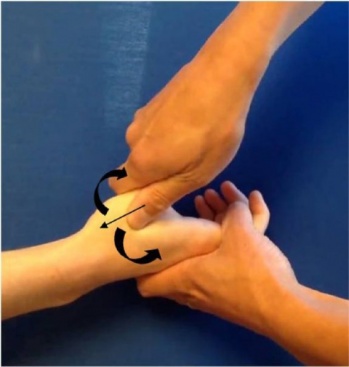Thumb CMC Grind Test: Difference between revisions
Evan Thomas (talk | contribs) mNo edit summary |
(I added picture and referencing) |
||
| Line 6: | Line 6: | ||
== Purpose == | == Purpose == | ||
The purpose of the Thumb CMC Grind Test is to assess the integrity of the thumb CMC joint. Reproduction of the patient's pain and crepitus is a positive test for arthrosis and synovitis. | The purpose of the Thumb CMC Grind Test is to assess the integrity of the thumb CMC joint. Reproduction of the patient's pain and crepitus is a positive test for arthrosis and synovitis. Therapists must be aware of the crank test which both evaluates the joint quality and translational laxity, the distraction test where a pain response indicates joint inflammation and volar compression of the first metacarpal base which also indicates joint inflammation<ref>Colditz JC, Koekebakker N. (2010) A New Splint Design for the Thumb CMC Joint [White Paper] published by Nea International bv / Push Braces, Maastricht-Airport, the Netherlands, www.push.eu</ref>. | ||
[[File:Grind test fig1.jpg|center|thumb|367x367px|https://www.ncbi.nlm.nih.gov/pmc/articles/PMC4920516/figure/fig1-1558944715616951/]] | |||
== Technique == | == Technique == | ||
The grind test is performed by gripping the patient's metacarpal bone of the thumb and moving it in a circle and loading it with gentle axial forces. A patient with thumb joint arthritis generally complains of a sudden sharp pain at the CMC joint. | The grind test is performed by gripping the patient's metacarpal bone of the thumb and moving it in a circle and loading it with gentle axial forces. A patient with thumb joint arthritis generally complains of a sudden sharp pain at the CMC joint which can also be associated with Crepitus<ref>https://medisavvy.com/thumb-grind-test/ accessed online October 17th, 2017</ref>. This indicates a positive test<ref name=":0">Model, Z., Liu, A. Y., Kang, L., Wolfe, S. W., Burket, J. C., & Lee, S. K. (2016). Evaluation of Physical Examination Tests for Thumb Basal Joint Osteoarthritis. ''Hand (New York, N.Y.)'', ''11''(1), 108–112. <nowiki>http://doi.org/10.1177/1558944715616951</nowiki></ref>. | ||
== Evidence == | == Evidence == | ||
Studies on the specificity and sensitivity of the Grind test were performed by Merrit et al using two examiners and Choa et al. The results are shown below; | |||
{| class="wikitable sortable" | |||
|+Sensitivity and Specificity Analysis<ref name=":0" /> | |||
= | !Author | ||
!Sensitivity | |||
!Specificity | |||
|- | |||
|Merritt et al | |||
|42% | |||
|80% | |||
|- | |||
|Meritt et al | |||
|53% | |||
|93% | |||
|- | |||
|Choa et al | |||
|30% | |||
|96.7% | |||
|} | |||
== References == | == References == | ||
Revision as of 14:12, 17 October 2017
Original Editor - Sharon Schumacher
Top Contributors - Admin, Rachael Lowe, Kim Jackson, Sharon Schumacher, Evan Thomas, WikiSysop, Fasuba Ayobami, Claire Knott, Wanda van Niekerk and Patti Cavaleri
Purpose[edit | edit source]
The purpose of the Thumb CMC Grind Test is to assess the integrity of the thumb CMC joint. Reproduction of the patient's pain and crepitus is a positive test for arthrosis and synovitis. Therapists must be aware of the crank test which both evaluates the joint quality and translational laxity, the distraction test where a pain response indicates joint inflammation and volar compression of the first metacarpal base which also indicates joint inflammation[1].
Technique[edit | edit source]
The grind test is performed by gripping the patient's metacarpal bone of the thumb and moving it in a circle and loading it with gentle axial forces. A patient with thumb joint arthritis generally complains of a sudden sharp pain at the CMC joint which can also be associated with Crepitus[2]. This indicates a positive test[3].
Evidence[edit | edit source]
Studies on the specificity and sensitivity of the Grind test were performed by Merrit et al using two examiners and Choa et al. The results are shown below;
| Author | Sensitivity | Specificity |
|---|---|---|
| Merritt et al | 42% | 80% |
| Meritt et al | 53% | 93% |
| Choa et al | 30% | 96.7% |
References[edit | edit source]
- ↑ Colditz JC, Koekebakker N. (2010) A New Splint Design for the Thumb CMC Joint [White Paper] published by Nea International bv / Push Braces, Maastricht-Airport, the Netherlands, www.push.eu
- ↑ https://medisavvy.com/thumb-grind-test/ accessed online October 17th, 2017
- ↑ 3.0 3.1 Model, Z., Liu, A. Y., Kang, L., Wolfe, S. W., Burket, J. C., & Lee, S. K. (2016). Evaluation of Physical Examination Tests for Thumb Basal Joint Osteoarthritis. Hand (New York, N.Y.), 11(1), 108–112. http://doi.org/10.1177/1558944715616951







